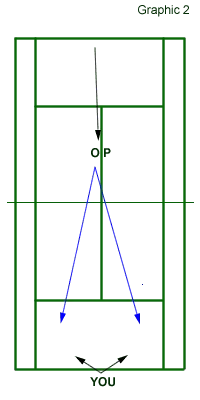Analyzing how to play and cover the court when your opponent moves up to the net, we’ll consider the following situations:
– you move away from the baseline center (your opponent attacks with a wide ball),
– you being at the baseline center (more or less).
First, recognize that when you are being attacked from the net, your reactions must be a lot quicker – the time the ball comes back from your opponent is shorter due to the smaller distance between players.
I’d advise you to adopt a low stance and be ready to not only move quickly to the ball but to shorten your strokes too – the shorter backswing and follow-through the better for you.
Mentally, prepare to make at least 2 shots in before you get the chance to put the ball away. Often, inexperienced players get impatient when their opponent comes up to the net – they want to finish the point (pass their net opponent) as soon as possible. Don’t! Make them volley. Wait for the right opportunity to attack or put the ball away!
A. If you are moving wide while your opponent attacks (see graphic 1 below)

The shot choice you will make from this position will affect your next move (as always don’t think that you must put the ball away from the first try; consider at least two shots that you will have to make!)
Even though from this position, going down-the-line is the best option considering that the court is shorter compared to the cross-court alternative, I personally prefer to defend by hitting cross-court most of the time (about 75% of the shots).
And here’s why:
1. If I hit down-the-line I will have to deal with a small margin for errors: higher net, shorter court, and narrow window to pass. If I get lucky, this can be a great option. But I do not rely on luck when I play because…
2. My opponent might get to my attempted down-the-line pass and angle it into the open court away from where I am. If I will try to chase that ball I will have to be very fast considering that it will pull me across the court and past the left singles sideline from where I am (see figure 1).
Considering the aforementioned arguments and thinking from a good court coverage point of view, choosing to hit the ball cross-court would be my main choice for the following reasons:
1. The ball travels longer and over the lowest part of the net – that will give me more time to recover and chase the next ball.
2. Even if my opponent will get to the ball (remember that you should not think your shot will be a put-away one; prepare for at least two hits), his/her options will be either cross-court (which is close to where I am) or if he/she wants to place the ball to the open court I will not have to run further than the left singles sideline to get to it (compared to the option when I try to pass down-the-line). (see graphic 1)
In conclusion, when your opponent charges the net with a wide ball, my advice would be to pass/hit cross-court (most of the time) because this choice puts you in a better position for the next ball. I consider going down-the-line a somewhat risky shot: do it only if you are very confident that you can put it away (pass your opponent), otherwise get ready to run across the court… and very fast.
B. If you are at the baseline center when your opponent charges the net (see graphic 2 below)

Thinking about court coverage, from this situation, I’d get ready to move inside the baseline to play the next ball.
Most of the time your opponent will go for angled volleys which will force you to step inside the baseline.
It is very important in order for you to become a better tennis player to THINK AHEAD, to anticipate your opponent’s next moves!
When he/she is at the net and you are just in front of him/her, your vulnerable area is the front court (service court).
In this situation, whatever your tactical options are, be prepared to move forward either for an angled (not too wide) or shorter ball.
It would be smart if you step on the baseline or inside of it as you see your opponent coming up to the net.